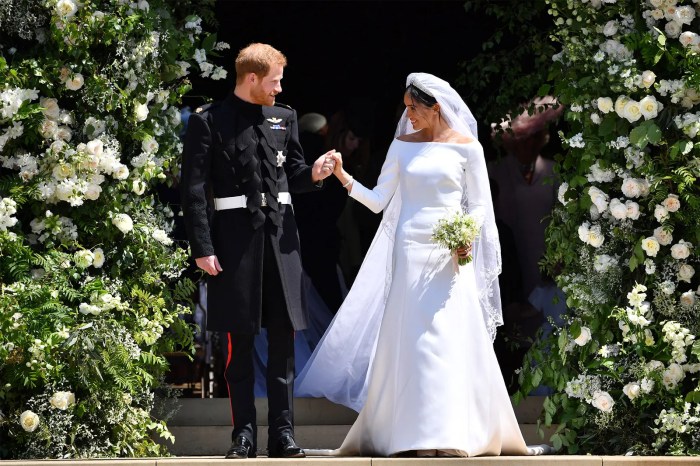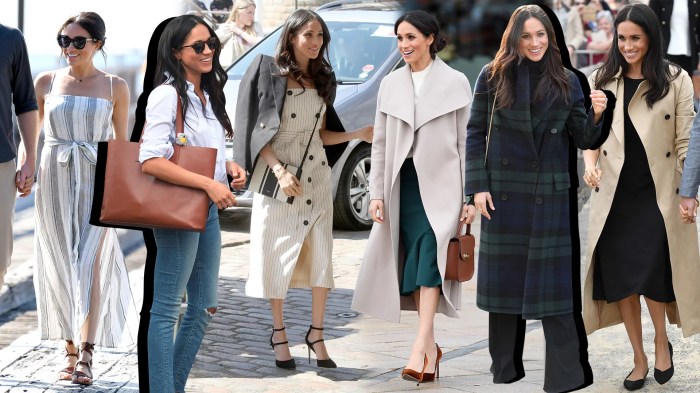Meghan Markle’s Wedding Dress: A Detailed Analysis
Meghan markle dress wedding – Meghan Markle’s wedding dress, unveiled on May 19, 2018, captivated the world. Its simple elegance, combined with subtle details, made it a modern classic and a significant moment in royal wedding history. This analysis delves into the design, the designer, the public reception, and the ethical considerations surrounding this iconic gown.
The Dress Itself
Designed by Clare Waight Keller for Givenchy, the dress featured a sleek, simple silhouette. The bateau neckline, a classic and elegant choice, was both modern and timeless. The fabric, a double-bonded silk cady, created a smooth, flowing drape, while remaining structured and refined. Minimalist embellishments were incorporated, with the only significant detail being the five-meter-long train. The overall effect was one of understated luxury and sophistication, a departure from the more heavily embellished gowns of some previous royal brides.
Compared to other royal wedding dresses, Meghan’s choice presented a stark contrast to the more ornate styles seen in previous decades. While Princess Diana’s dress was famously extravagant, and Kate Middleton’s gown was more traditional, Meghan’s dress was decidedly modern and minimalist. This reflects a shift towards a more contemporary aesthetic in royal fashion.
| Bride | Designer | Fabric | Style |
|---|---|---|---|
| Princess Diana | David and Elizabeth Emanuel | Silk taffeta, antique lace | Romantic, voluminous |
| Kate Middleton | Sarah Burton for Alexander McQueen | Satin, lace | Traditional, classic |
| Meghan Markle | Clare Waight Keller for Givenchy | Double-bonded silk cady | Modern, minimalist |
The Designer: Clare Waight Keller, Meghan markle dress wedding
Clare Waight Keller, known for her elegant and sophisticated designs, brought her unique design philosophy to Meghan Markle’s wedding dress. Prior to her appointment as Givenchy’s creative director, she held prominent positions at Chloé and Pringle of Scotland, showcasing a consistent commitment to clean lines and luxurious fabrics. Her experience in creating both ready-to-wear and haute couture garments clearly influenced the final design, resulting in a dress that was both wearable and exquisitely crafted.
The design process involved numerous fittings and revisions, with Keller collaborating closely with Markle to ensure the dress perfectly reflected her personal style. Initial sketches explored various silhouettes and necklines before settling on the final, minimalist design. The attention to detail was meticulous, with each seam and stitch contributing to the overall elegance of the gown.
The Veil and Accessories
Meghan Markle’s veil, five meters long, was crafted from silk tulle and featured embroidered flowers representing the 53 countries of the Commonwealth. This symbolic detail added a layer of meaning and significance to the already stunning garment. The choice of a simple, yet meaningful veil, contrasted with the elaborate veils of some previous royal brides. The addition of Queen Mary’s diamond bandeau tiara further enhanced the overall regal aesthetic.
The jewelry was understated, yet elegant. She opted for simple diamond earrings and a bracelet, allowing the dress and veil to remain the focal point. This contrasted with some royal weddings where brides opted for more opulent jewelry. The overall effect was one of refined elegance and understated luxury, perfectly complementing the minimalist design of the dress.
Public Reception and Impact
The public’s reaction to Meghan Markle’s wedding dress was overwhelmingly positive. The dress was praised for its simple elegance, modern design, and timeless appeal. It immediately became a source of inspiration for brides worldwide, leading to numerous replications and interpretations. The minimalist aesthetic, previously less common in royal weddings, set a new trend in bridal fashion, influencing designers and inspiring brides to opt for cleaner lines and more understated elegance.
The dress’s impact extended beyond the bridal industry. It was frequently referenced in popular culture, appearing in television shows, films, and social media. Its influence on fashion trends is undeniable, with designers incorporating similar silhouettes, necklines, and fabric choices into their collections.
The Ethical and Sustainable Aspects

Source: tatler.com
The ethical and sustainable aspects of Meghan Markle’s wedding dress have been a subject of discussion. While details regarding the specific sourcing of materials remain limited, Givenchy is committed to responsible sourcing practices, implying the use of sustainable materials and fair labor practices.
- Positive: The use of high-quality, durable materials suggests a commitment to longevity and reduced consumption.
- Positive: Givenchy’s commitment to responsible sourcing suggests an effort to minimize negative environmental and social impacts.
- Unknown: Specific details regarding the origin of materials and manufacturing processes remain largely undisclosed, making a definitive assessment difficult.
Visual Representation

Source: vogue.com
The dress was a vision of understated elegance. The ivory silk cady flowed gracefully, creating a smooth, almost liquid drape. The bateau neckline elegantly framed the shoulders and neck, while the clean lines of the silhouette emphasized the bride’s figure. The texture of the fabric was smooth and luxurious, with a subtle sheen that caught the light. The overall aesthetic was one of refined simplicity and timeless grace.
The dress projected an image of confidence and modern sophistication. Its simplicity allowed Meghan Markle’s natural beauty and grace to shine through, creating a memorable and iconic image. The dress was a perfect reflection of her personal style, balancing classic elegance with contemporary minimalism.
The dress perfectly captured Meghan Markle’s personal style: sophisticated, minimalist, and effortlessly chic. The choice to forgo excessive embellishment showcased her preference for understated elegance, while the clean lines and classic silhouette demonstrated her timeless taste.
Quick FAQs: Meghan Markle Dress Wedding
Was Meghan Markle involved in the design process of her wedding dress?
While Clare Waight Keller was the designer, reports suggest Meghan Markle collaborated closely, sharing her vision and preferences to create a gown reflecting her personal style.
What type of silk was used in Meghan Markle’s wedding dress?
The dress was made from a double-bonded silk cady, known for its luxurious drape and subtle sheen.
Where was the fabric for Meghan Markle’s wedding dress sourced?
Information on the precise sourcing of the silk is not publicly available, however, ethical sourcing was a stated consideration in the design process.
How much did Meghan Markle’s wedding dress cost?
The exact cost remains undisclosed, although estimates vary widely.
